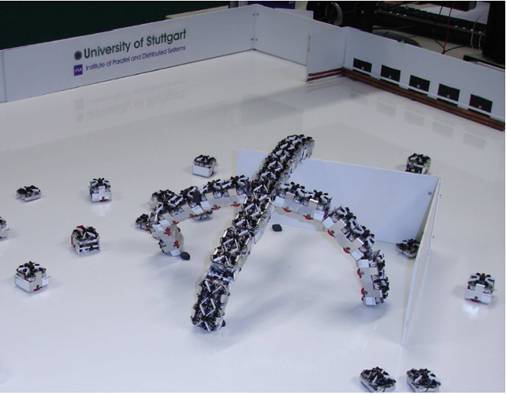The aim of the ‘Symbiotic Evolutionary Robot Organisms’ project, or ‘Symbrion’, is to understand the principles that govern how robots can form themselves into a single artificial organism. The technique enables them to interact collectively with the physical world, and might ultimately be applied to real-world tasks such as rescuing earthquake victims.
‘Multi-robot organisms’ are made up of large swarms of individual robots, each slightly larger than a sugar cube, which work together to form a single artificial life-form. The organisms are able to share information and energy with one another, and to manage their own hardware and software.

The consortium is composed of eleven international partners. The University of York’s role, for example, is led by Dr. Jon Timmis and Professor Andy Tyrrell of the Intelligent Systems Group in the Department of Electronics, and they are out to develop an artificial immune system which can protect both the individual robots and the larger collective organism.
The immune system will be able to detect faults and make recommendations to a high-level control system about corrective action, much as a person’s adaptive immune system monitors status to keep the body healthy.
When the robots join together into a single organism, each robot will be able to share this crucial information with others, creating an overall system which can evolve in the face of new problems – just as a natural immune system is able to cope with unfamiliar pathogens.
Jon Timmis said: “This is an increasingly important area of research. We may be able to use the collaborative power of many robots in situations where human intervention isn't possible. For instance, a Symbrion swarm could be released into a collapsed building following an earthquake, and form themselves into teams to lift rubble or search for survivors.
“This kind of thing is clearly a long way from being realised, but work in this project will allow us to start building the robots of the future.”
The project is funded internationally by the European Union as part of the Future Emerging Technologies programme.
The project partners are:
•University of York (England)
•University of the West of England (England)
•University of Stuttgart (Germany)
•University of Graz (Austria)
•Vrije University (Netherlands)
•University of Karlsruhe (Germany)
•Flanders Institute for Biotechnology (Belgium)
•Eberhard Karls University (Germany)
•Université Libre de Bruxelles (Belgium)
•Institut National de Recherche en Informatique at Automatique (France)
•Institute of Microelectronic Application (Czech Republic)





Comments